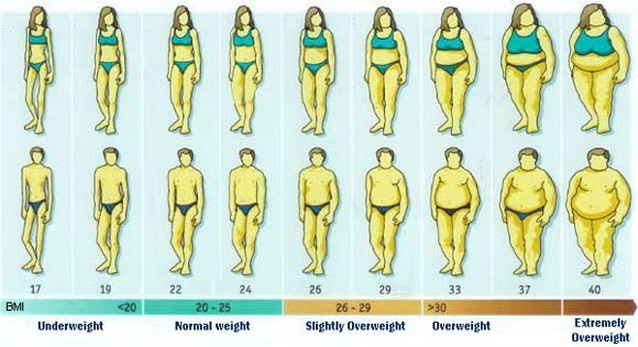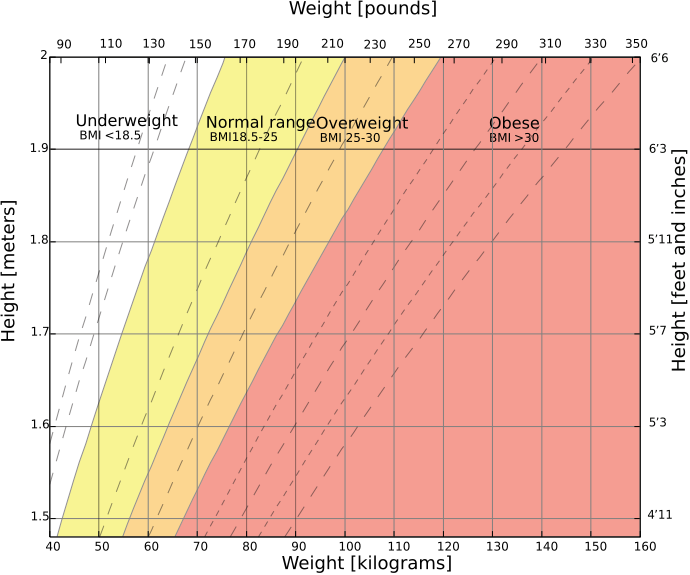BMI Calculator : The body mass index is calculated by dividing the square of the height in meters by the weight in kilograms.
Contents
- 1 BMI Calculator
- 1.1 BMI Calculator Chart
- 1.2 BMI Calculator Graph
- 1.3
- 1.4 Who invented BMI calculator?
- 1.5 Who uses BMI calculator?
- 1.6 Does BMI give an indication of the percentage of fat in the body?
- 1.7 How to you maintain to have a great, fit and healthy body?
- 1.8 What if I have high BMI?
- 1.9 Understanding BMI For Women
- 1.10 What BMI doesn’t tell you about your health?
BMI Calculator
Your BMI:
BMI Calculator Chart
| Check Your BMI Results | |
| BMI Value | Body Type |
| Under 18.5 | Underweight |
| 18.5 to 24.9 | Normal |
| 25.0 to 29.9 | Overweight |
| 30 to 34.9 | Obese Class 1 |
| 35 to 39.9 | Obese Class 2 |
| 40 and Above | Obese Class 3 |

BMI Calculator Graph
The following graph illustrates the various bands in the Body Mass Index and how they relate to an individual’s weight.
Who invented BMI calculator?
The concept of the body mass index (BMI) was developed by Belgian mathematician Adolphe Quetelet in the 19th century. Quetelet developed the concept of BMI as a way to measure the level of fatness in a population and to identify individuals who were at risk of health problems due to excess body weight. Quetelet’s original formula for calculating BMI was based on the height and weight of an individual, and it was expressed as a ratio of weight to height squared.
This formula is still in use today, although it has been modified slightly over the years. Quetelet’s work laid the foundation for the modern concept of BMI and the use of BMI as a measure of body fatness. The first BMI calculator was developed in the 1970s by the Metropolitan Life Insurance Company, which used the formula developed by Quetelet to create a tool for calculating BMI based on height and weight. Since then, many different BMI calculators have been developed, and they are now widely available online and in mobile apps.
Who uses BMI calculator?
BMI calculators are used by a wide range of people, including individuals, health care professionals, and researchers. Individuals may use a BMI calculator to determine their own BMI and to assess their risk of health problems related to excess body weight. Many people use BMI calculators as a starting point for discussing their weight and health with a health care provider. Health care professionals, such as doctors and registered dietitians, may use BMI calculators as part of their assessment of a patient’s health.
They may use the BMI calculator to determine a patient’s BMI and to assess their risk of health problems related to excess body weight. Researchers may also use BMI calculators as part of their studies on the relationship between body weight and health. They may use BMI calculators to collect data on the BMI of a large group of people and to analyze the relationship between BMI and various health outcomes. Overall, BMI calculators are used by a wide range of people for a variety of purposes, including assessing individual health and conducting research on the relationship between body weight and health.
Does BMI give an indication of the percentage of fat in the body?
The BMI does not give an indication of the percentage of fat in the body, as it does not take into account the muscle/fat ratio. In having a healthy body is very important to have a longer life. One should be know what BMI is and what the connection for a healthy body and lifestyle is. Knowing your body fat is very important and should correspond or appropriate with the height and weight of the person. Doctors used this to estimate the fats with their patients.
BMI means Body Mass Index which estimate the body fat of a person have using the height and weight. It does not give the exact measurement of fat compose in a body but at least it gives a fair accurate estimate or assessment of it. After calculating and knowing how much fat is estimate in your body the person can know if he or she needs to lose or gain fat.
With it one can classify what category the person is if he or she is overweight, underweight, obese and most important healthy weight. Some say that if one has a high BMI you have the great possibility developing some diseases like heart disease, sleep apnea, high blood pressure, and urinary stress incontinence, high cholesterol and blood lipids, gastro esophageal reflux, Type 2 Diabetes, female infertility, some cancers and other more. Even you know how to calculate BMI it is still best to still see the doctor especially if this is the first time you are calculating. Ask them some guidance if you want to continue on monitoring your BMI. Doctors can explain it clearly more than just reading on your own because they can tell you what is needed to know and you can ask questions if you do not understand something.
How to you maintain to have a great, fit and healthy body?
If you are thinking or planning of starving your body you better think twice because that is not a healthy way to have one. If you think cutting or reducing the calories you take is simple thing to do you need to consult a doctor. Calories that is taken in and taken out should be balance. Remember that when you lose weight it means that there are more calories that leave your body.
If this happens some people get hungrier. Get to know more how to balance your diet so that you can maintain the desire calories in your body. So if you are planning to lose some weight there are ways to do it right. Ask health professionals for the right diet that is appropriate for your body and lifestyle to be able to lose weight. Eat more food that has more protein because they say that this can lessen appetite and also cut cravings at least 60%. This is also a great way to burn more calories.
Another is avoiding drinks that have sugar on it like soft drinks or sodas, fruit juices and other. Drinking water more is also a great way to lose weight. Aside from this exercise and some lift weights can also help burn calories. The amount of calories that leaves your body should also be near or almost the same of what you in take to replenish the need of your body. If not you will feel and become weak. Make sure you know what is right for your body.
What if I have high BMI?
A high BMI is linked to a number of health problems These include high blood pressure, too much cholesterol in the blood, and problems regulating blood sugar (which can lead to diabetes).
All these things can lead to heart attacks, strokes or other health problems that can shorten your life. Monitoring Your BMI Regularly checking your Body Mass Index every few months is a good way to keep an eye on your health. Our free BMI calculator is here permanently so you are welcome to bookmark this page (Ctrl+D) and come back here whenever you want to.
Understanding BMI For Women
BMI also known as Body Mass Index refers to the figure derived from calculation of a person’s weight and height. This figure helps in determining the amount of fat levels in the body and to monitor, control and hinder complications that may arise from being overweight or underweight. This subsequently helps individuals to maintain a healthy weight.
The BMI of a person is his or her weight in Kilograms divided by his or her height in meters squared. The calculations are done using a BMI calculator, and a BMI chart. BMI for women is obtained in the same way that BMI for men, teenagers and children are obtained. The calculators and charts are designed to be used by people of different age and social backgrounds regardless of gender. BMI for women is however interpreted differently compared to men’s due to difference in physiological factors and the fact that women tend to have more fat in the body compared to men, who have a higher basal metabolic rate.
Women’s bodies and weight change significantly as they grow older and since having an unhealthy weight increases one’s chances of developing medical complications and conditions such as diabetes, hypertension, stroke, gallbladder, several cancers and many more. It is therefore important for every woman to know their BMI.
This will assist greatly in maintaining a healthy weight and age gracefully, without weight related complications. Getting one’s BMI as a woman is not a difficult task. It can be done in 3 easy steps. Namely: Weight yourself on a weighing scale, while naked or in your innerwear, in the morning after using the bathroom and before breakfast.
Record your weight in the BMI chart Measure your height in inches. This is achieved by standing straight against the wall, back first, placing and placing a mark on the wall, where the top of your head reaches and measuring. Divide your weight by your height and multiply the figure you get by the number 703. This will give you your body mass index.
Once you have received the figure that represents your BMI, you will be able to know whether you are underweight, overweight or have a normal weight. Some online sites have BMI calculators that are self explanatory and easy to use that will help you determine your BMI. A high or abnormally low BMI is usually considered a health risk and measures and you should take necessary measures to bring your BMI back to normal.
This can be done by maintaining a healthy lifestyle that involves exercising and maintaining a healthy diet if you are overweight. If your BMI indicates that you are underweight, it is important to consult with nutritionist to help you improve your BMI.
BMI for women is also important in pregnant women to help them maintain a healthy weight, which is crucial for the health of pregnancy. Having a healthy BMI does not necessarily mean you are free from complications related to weight issues because these can also be caused by hereditary factors and others such as exposure to disease and unhealthy environments. Necessary steps and precautions must be taken to maintain a healthy lifestyle regardless of your BMI.


